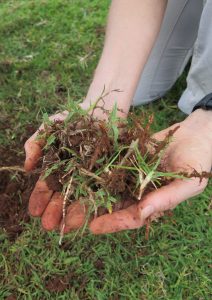In recent research, we showed that there is potential to enhance soil functions and their resilience by manipulating plant functional diversity. In particular, more diverse mixtures of plants rapidly enhanced soil properties during early stages of restoration (see articles here and here).
 This is due to the influence of roots. High diversity plant communities are associated with greater abundance of fine roots of high specific root length. These have intimate contact with the soil environment and a high surface area for connecting microbes and root exudates. This stimulates microbial activity and rates of nutrient and carbon cycling in the soil. It also enhances soil aggregate stability, a vital structural property of soil.
This is due to the influence of roots. High diversity plant communities are associated with greater abundance of fine roots of high specific root length. These have intimate contact with the soil environment and a high surface area for connecting microbes and root exudates. This stimulates microbial activity and rates of nutrient and carbon cycling in the soil. It also enhances soil aggregate stability, a vital structural property of soil.
We also found that sowing plant species into degraded soil with a wide variety of rooting depths rapidly (i.e. within 3 years) led to greater resistance of microbial-driven soil functions to drought which could help buffer climate extremes.
The potential to exploit plant diversity to enhance soil functioning and plant production, has largely been tested in temperate regions. Assessing its effectiveness in humid regions of sub-Saharan Africa requires new knowledge about the plant species of grazing lands and their capacity to persist in degraded soils and enhance soil functions during the early stages of restoration under different grazing regimes.
To do so, we will carry out two experiments:
 Experiment 1 characterizes the functional traits of certain plant species, selected on the basis of local knowledge and their potential to promote soil functions that underpin the restoration of degraded land. Selected species will be grown in controlled conditions in soils taken from the two sites, resulting in a detailed characterization of their traits.
Experiment 1 characterizes the functional traits of certain plant species, selected on the basis of local knowledge and their potential to promote soil functions that underpin the restoration of degraded land. Selected species will be grown in controlled conditions in soils taken from the two sites, resulting in a detailed characterization of their traits.
Experiment 2 builds on these results and tests the potential for combinations of plant-trait based groups to enhance the functioning of degraded soils, using field-based mesocosms. Over 100 mesocosms for each site will be established, running for one and a half years, thereby encompassing a full growing season.
This new experimental knowledge about grazing land plant diversity will provide proof-of-concept for large-scale, longer-term, field-based manipulation experiments.
The third part of the project investigates current and alternative approaches to livestock management.